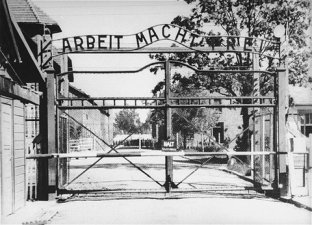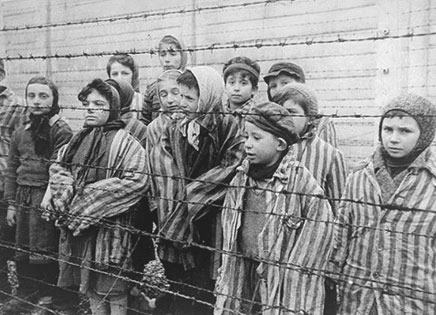|
|
|
| Auschwitz is the best known of all the Nazi death
camps. It was a symbol of terror and genocide. Polish
government has maintained the site as a memorial. Only a few
barracks remain, but are now being restored. It isn't a very
pleasant site, but is the largest, most lethal and dangerous. It was
set in Poland for three reasons. First, it has the largest concentration
of Jews in Europe. Second, Himmler knew even under Nazi control ,
this operation couldn't be carried out so they didn't want it in
Germany. Third, Poland has a long history of anti-Semitism and
Germans counted on help from them. |
|
| Zyklon B was brought to Auschwitz in the summer of 1941, as
a vermin killer and disinfectant. Jewish men, women, and children
were killed with poison gas in the gas chambers. Regardless, of age,
gender, occupation, citizenship, they all died if they were Jewish.
But the elderly, pregnant women, and children were sent to immediate
death. After the completion of four crematories with gas chambers in
Auschwitz-Birkenau burning corpses in Crematorium 1 was halted.
Auschwitz contained three camps which are Auschwitz 1, Auschwitz-Birkenau
2, and Auschwitz-Monowitz 3, as well as forty other sub camps.
Auschwitz 1 was also named Stammlager. It was practically in the
center of German occupied Europe. |
|
|
| When prisoners first arrived they got a blanket and were
sent to their barracks. Some unlucky prisoners were beaten as soon
as they got there, not having any clue what was to come. "Arbeit
Macht Frei" (work brings freedom) is the sign hanging over the
entrance at Auschwitz. Not all the prisoners at Auschwitz were Jews.
Diaries, diplomas, and family photographs were burned. Not only did
the Germans want to get rid of the Jews, they wanted to destroy the
remnants of when they were there. During World War 2 only one man
managed to get prisoners out of Auschwitz and that was Oscar Shindler. Out
of everyone's belongings from the camp they found seven thousand pounds of
gold, fifty thousand of silver, sixteen thousand carats of diamonds
and money from forty-eight countries. Escape at Auschwitz was
extremely rare but not unknown. "Tomorrow Morning" was
Auschwitz's slang for NEVER. But if you did break free, at your town the Jews were still not welcome. |

|
|
| The first women's camp was established in 1942,
dividing the men's camp with a brick wall. But August 16, 1942
the women's camp was dissolved and moved to Birkenau. i So many women were
in the camps, that there was no room, forcing them to keep adding
on. Women suffered more than men in many, many ways. Although men
and women both went to the "Sauna" there were differences.
Such as, men had to undress in front of other men, but women had to be
undressed in front of the men, taking harassment; forceful and humiliating
physical contact. The Sauna was the first stage of the
de-humanization period. Pregnant women were put to death upon their
arrival. The average life expectancy was shorter than a mans because
women lost shape much faster. Mothers who held babies in their arms
were gassed with them. The children were prohibited to drink water from
camp because of contamination. The number of children killed by
Hitler is unknown and never will be. There are a few.........but there
were no happy endings- they were all murdered at Auschwitz. |
| With so many hundreds of people crowded into an area the
sanitary conditions were appalling. The barracks had muddy floors,
then a few or no bathroom facilities at all. An outdoor bathroom is
a long ditch, very wide and very deep and had danger of falling in.
There were buckets in the barracks but were most of the time filled. So
there was a rush in the morning to the latrine pits. They were
forced to keep their barracks clean, yet had no pail or broom. With
filth and lack of ventilation, contaminated air, caused an even greater
health hazard. Sometimes food bowls were even used as chamber
pots. It would be a week before there clothes would be washed.
Some would have to wait five months for a shower and then share with five
other prisoners. |

|
|
| |
| The more that died on their own were fewer the Germans had
to kill. Despite the bad conditions prisoners kept trying to
survive, one day at a time. If you weren't fifteen or older you went
straight to the gas chambers. Fritzie Fritzall said "I only survived
survived because I told them I was fifteen." After you got your
number you no longer had a name. Blows to the head and beatings were
daily and nothing out of the ordinary. Orders were given only in
German. Those who didn't understand and could not respond
immediately were beaten, slapped, ect. Death became more normal than
life. |
| |
| Auschwitz was the largest of all the Nazi death camps, and
the largest mass destruction of Jews. The number of deaths at Auschwitz is
unknown but sadly very high. The people who did survive Auschwitz
lives would never be the same. Crematory II was destroyed by
the SS using explosives on January 20, 1945, along with the crematory III
just seven days before the prisoners were let out of Auschwitz. Crematory
IV had been destroyed by the inmates on October 7, 1944. But the prisoners
of Auschwitz were liberated on January 27, 1945. |


